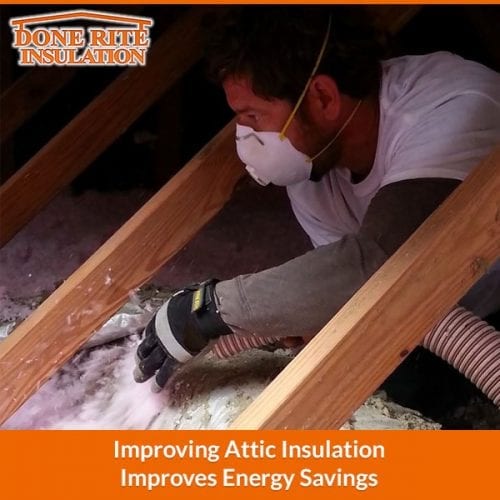 For your roof to perform at its best everything must work well together – including your attic insulation and ventilation system. When you have the correct roof insulation in place most of your home’s heat won’t escape through the attic during the winter months and you’ll also be protected from the heat throughout the summer months. This will keep your heating and cooling expenses in check.
For your roof to perform at its best everything must work well together – including your attic insulation and ventilation system. When you have the correct roof insulation in place most of your home’s heat won’t escape through the attic during the winter months and you’ll also be protected from the heat throughout the summer months. This will keep your heating and cooling expenses in check.
Why Your Home Needs Attic Insulation
The U.S. Department of Energy says that most American homes are under-insulated. This is why about 50 – 70% of the energy used within the average American home is for heating and cooling. You don’t have to be stuck with outrageous energy bills though. When you have the right attic insulation installed your roof can perform at its best, saving you about 20% on your utilities.
What Insulation Does
The reason why heat tries escaping through a home’s roof during the wintertime is that heat’s tendency is to move toward the cold. Of course, this is also why heat tries to enter a home in the summertime. Typically, this air exchange will happen in your attic, basement, and garage. When these areas have the proper insulation though, because it’ll trap the air in its tiny pockets, thus resisting the heat transfer.
Knowing how Much Insulation You Really Need
A few things factor into how much roof insulation is necessary for a home including the climate you live in, how old your home is, and how much insulation is already present there. With this in mind, you must also understand how insulation’s thermal resistance is rated – what its “R value” is. The higher this value is, the better insulated your home will be. According to the U.S. Department of Energy and the International Energy Conservation Code homeowners in Florida should use 12 inches of R30 – R60 insulation.
Understanding the Different Types of Roof Insulation
There are a few types of attic insulation you should consider:
- Blow-in or Loose-fill fiberglass or cellulose insulation: This starts as large blocks that a machine chews up into small pieces that are sprayed into your home’s attic. It’s beneficial because it can reach hard to reach places there.
- Roll or batt fiberglass or rockwool insulation: This is laid out in huge sheets. Although it has a higher R value than loose-fill insulation, it might not fill in all the gaps in your attic. Additionally, this type of attic insulation isn’t ideal for an attic that doesn’t have standard joist space or one with lots of obstructions to work around.
Why You Should Install Insulation When Re-Roofing Your Home
When you install roof insulation when you re-roof your home you avoid disrupting your life further. You also ensure that your roof can perform at its best. There won’t be any leaks that cause mold or mildew to grow there either.
For more information about roof insulation contact Done Rite Insulation today. Over the years they’ve quickly and easily installed insulation in attics throughout the area. Make sure they’re the name you turn to when you’re ready to improve your own home’s insulation.









